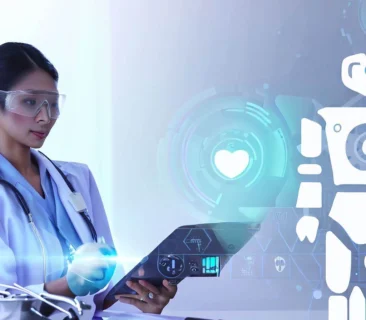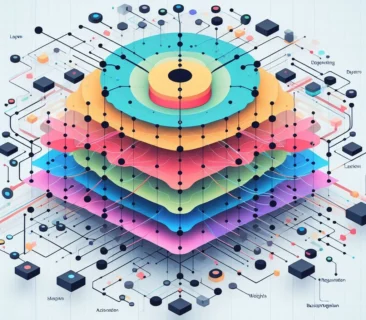Introduction:
In an era where innovation is the lifeblood of progress, keeping a finger on the pulse of emerging trends in technology is essential. Welcome to NextechPulse, your trusted source for staying at the forefront of the digital revolution. In this article, we delve deep into the world of “Emerging AI Trends in Predictive Analytics and Data Interpretation.”
Artificial Intelligence (AI) has revolutionized the way we approach data analysis, transforming it from a static exercise into a dynamic, predictive force. As businesses and industries increasingly rely on data-driven decisions, understanding the latest trends in AI becomes imperative for those seeking to remain competitive and innovative.
Join us on this exciting journey as we explore the groundbreaking advancements in predictive analytics and data interpretation powered by AI. We’ll unravel the mysteries behind these transformative technologies, share real-world applications, and peer into the future of AI’s role in shaping the digital landscape.
So, fasten your seatbelts, and let’s embark on a voyage through the ever-evolving realm of AI, where data isn’t just data-it’s the key to unlocking the future.
Predictive Analytics Explained: Enhancing Decision-Making with AI
In our digital age, data is more than just numbers and figures; it’s a powerful tool for informed decision-making. But what if we could take it a step further? This is where predictive analytics, supercharged by artificial intelligence (AI), comes into play. Let’s dive into the world of predictive analytics and discover how AI is making it smarter and more impactful than ever before.
What Is Predictive Analytics?
Predictive analytics is like having a crystal ball for your data. It’s a technology that uses historical data and machine learning algorithms to forecast future trends, behaviors, and outcomes. Think of it as weather forecasting for your business or industry. By analyzing past data, it can predict future events or behaviors with a remarkable degree of accuracy.
Why Is Predictive Analytics Important?
Predictive analytics has a crucial role in helping organizations make better decisions. Whether you’re a retailer predicting customer preferences, a healthcare provider anticipating patient needs, or a financial institution managing risks, predictive analytics can provide insights that lead to more effective strategies and improved outcomes.
AI’s Role in Supercharging Predictive Analytics
Now, let’s introduce our AI superstar. Artificial intelligence, with its ability to process vast amounts of data and learn from it, takes predictive analytics to new heights. Here’s how:
1. Data Crunching:
AI can handle massive datasets swiftly, making it possible to analyze more information than ever before. This means better predictions and more accurate insights.
2. Pattern Recognition:
AI excels at spotting subtle patterns and relationships within data that might elude human analysts. It can find correlations and trends that humans might overlook.
3. Continuous Learning:
AI models continuously learn and adapt. As new data becomes available, AI systems can refine their predictions, ensuring they stay relevant and accurate over time.
Real-World Applications
Predictive analytics powered by AI is not confined to any single industry. Its versatility makes it applicable across various sectors:
– E-commerce:
Recommending products to customers based on their browsing and purchase history.
– Healthcare:
Predicting patient outcomes and identifying potential health issues before they become critical.
– Finance:
Assessing credit risk and detecting fraudulent transactions.
– Manufacturing:
Optimizing production processes and predicting equipment failures.
The Power of Predictive Analytics in Action
Imagine a retail business that uses predictive analytics to forecast customer demand. By analyzing past sales data and external factors like seasonality and economic trends, the business can make more accurate inventory decisions. This not only prevents overstocking but also ensures products are available when customers want them, enhancing customer satisfaction and maximizing profits.
In healthcare, predictive analytics can identify patients at high risk for specific diseases. By analyzing patient data and historical health trends, healthcare providers can intervene early, offering preventive care and reducing healthcare costs.
Data Interpretation with AI: Unleashing the Potential of Information
In our data-rich world, understanding the significance of information is a valuable skill. But what if we told you that AI could not only help us interpret data but also unlock hidden insights and potential? That’s precisely what we’ll explore in this section as we discuss how AI transforms data interpretation.
Making Sense of Big Data
Data interpretation is like solving a puzzle with millions of pieces. It involves analyzing information to draw meaningful conclusions. In today’s digital age, we’re bombarded with vast amounts of data daily. This data includes everything from social media posts and online transactions to sensor readings and medical records.
The AI Advantage in Data Interpretation
Here’s where AI steps in as our data-savvy assistant. AI can process colossal datasets with lightning speed, something human analysts simply can’t match. But its true power lies in its ability to uncover patterns and insights that might elude the human eye.
1. Pattern Recognition:
AI can identify patterns within data, even when those patterns are complex or subtle. This skill is particularly useful for spotting trends and anomalies.
2. Natural Language Processing (NLP):
AI can understand and process human language, making it invaluable for analyzing text data like customer reviews, emails, or social media comments.
3. Image and Video Analysis:
AI can also interpret visual data, including images and videos, which is essential in fields like healthcare, where medical images can hold critical information.
Real-World Applications of AI in Data Interpretation
The impact of AI in data interpretation spans across various industries:
– Finance:
AI can analyze market trends, news sentiment, and financial reports to make investment recommendations.
– Healthcare:
AI interprets medical images, analyzes patient records, and assists in diagnosing diseases.
– Retail:
AI interprets customer data to personalize shopping experiences and predict trends.
– Manufacturing:
AI monitors machinery and detects anomalies in real-time to prevent breakdowns.
The Power of AI in Healthcare Data Interpretation
Let’s focus on healthcare to illustrate the importance of AI in data interpretation. Medical data is vast and diverse, comprising patient records, test results, and medical images. AI algorithms can rapidly sift through this information, identifying patterns indicative of diseases or treatment responses.
For example, in radiology, AI-powered image interpretation can assist doctors in detecting tumors, fractures, and other abnormalities from X-rays, MRIs, or CT scans. This not only speeds up diagnosis but also improves accuracy.
In patient records, AI can help identify patients at high risk for specific conditions, enabling early intervention. Moreover, it can analyze treatment outcomes to refine healthcare strategies continually.
Machine Learning Advancements: The Brains Behind Predictive Analytics

Welcome back to our journey through the world of emerging AI trends. In this section, we’ll explore how machine learning plays a pivotal role in the advancements of predictive analytics, making it even more accurate and insightful.
Understanding Machine Learning
Machine learning is like having a self-improving brain for your computer systems. It’s a subset of AI that focuses on training algorithms to learn from data and improve their performance over time. Instead of being explicitly programmed, these algorithms adapt and make predictions based on patterns they identify in the data they analyze.
Why Machine Learning Matters in Predictive Analytics
Machine learning brings a dynamic element to predictive analytics. Here’s how it enhances the process:
1. Automated Learning:
Machine learning models can automatically learn from new data without constant human intervention, making them adaptable to changing conditions.
2. Complex Patterns:
These algorithms excel at recognizing intricate patterns and relationships in data, enabling them to make more accurate predictions.
3. Continuous Improvement:
As they process more data, machine learning models get better at making predictions, which means they become increasingly valuable over time.
Real-World Applications of Machine Learning in Predictive Analytics
Machine learning’s impact is profound across various industries:
– Finance:
Predicting stock prices, detecting fraud, and optimizing investment portfolios.
– Healthcare:
Personalizing treatment plans, predicting disease outbreaks, and improving patient care.
– Retail:
Recommending products, optimizing supply chains, and predicting customer buying behaviors.
– Transportation:
Enhancing traffic management, predicting maintenance needs, and optimizing routes for logistics.
Machine Learning in Action: Financial Forecasting
To illustrate the power of machine learning in predictive analytics, let’s consider financial forecasting. In the world of finance, predicting stock market movements accurately is a challenge that has captivated investors for generations.
Machine learning algorithms can analyze vast datasets containing historical stock prices, economic indicators, news sentiment, and more. By identifying patterns and correlations, these algorithms can make predictions about future price movements.
Moreover, machine learning models can adapt to changing market conditions. If new factors become relevant, the model can incorporate them into its predictions, ensuring that it remains up-to-date and accurate.
Real-World Applications:
Welcome back to our journey through the exciting world of emerging AI trends. In this section, we’ll explore real-world applications where AI is making a tangible impact through predictive analytics and data interpretation.
1. E-commerce and Personalization:
One of the most visible applications of AI in predictive analytics is in the realm of e-commerce. Have you ever noticed how online stores seem to recommend products tailored specifically to your tastes? That’s AI at work. By analyzing your past purchases, browsing history, and even your mouse movements on the website, AI algorithms can predict what products you’re likely to be interested in. This not only enhances the shopping experience but also boosts sales for businesses.
2. Healthcare and Early Disease Detection:
In healthcare, AI’s predictive power is saving lives. Medical professionals use AI to analyze patient data, such as blood tests, genetic information, and patient history, to identify individuals at high risk for certain diseases like diabetes or cancer. By detecting potential health issues early, doctors can intervene with preventive measures, improving patient outcomes and reducing healthcare costs.
3. Financial Risk Assessment:
In the world of finance, AI plays a crucial role in assessing risk. Whether it’s for individuals applying for loans or businesses seeking investments, AI can analyze financial data, credit history, market conditions, and more to determine the level of risk involved. This helps financial institutions make informed decisions about lending or investing.
4. Manufacturing and Predictive Maintenance:
In manufacturing, unexpected equipment breakdowns can lead to costly downtime. AI comes to the rescue by analyzing sensor data from machinery. It can predict when a machine is likely to fail and schedule maintenance proactively. This not only reduces downtime but also extends the lifespan of equipment, saving companies money in the long run.
5. Transportation and Traffic Management:
If you’ve ever been stuck in traffic, you’d appreciate the importance of efficient traffic management. AI is employed in transportation systems to predict traffic patterns, optimize traffic light timings, and even anticipate accidents or congestion. This results in smoother traffic flow, reduced fuel consumption, and less time spent in traffic jams.
6. Energy Efficiency:
In our increasingly eco-conscious world, energy efficiency is paramount. AI is used in buildings and industries to predict energy consumption patterns. By analyzing data from sensors and weather forecasts, AI can optimize heating, cooling, and lighting systems, reducing energy waste and lowering utility bills.
7. Weather Forecasting:
Speaking of weather forecasts, AI has revolutionized our ability to predict weather conditions accurately. By analyzing vast amounts of meteorological data from satellites, sensors, and historical records, AI can provide us with more precise and timely weather forecasts. This has implications for disaster preparedness and agriculture, among other things.
Conclusion:
As we wrap up our exploration of emerging AI trends in predictive analytics and data interpretation, it’s clear that artificial intelligence is a force that’s reshaping our world. From e-commerce personalization to healthcare advancements and traffic management, AI’s ability to predict and interpret data is driving innovation across industries.
These technologies aren’t just improving efficiency and convenience; they’re saving lives, conserving energy, and making our daily lives smoother. As we stand at the crossroads of technology and progress, embracing these AI-driven insights is key to staying competitive and making informed decisions.
The journey doesn’t end here. The world of AI is dynamic, and new trends and breakthroughs are constantly on the horizon. To stay at the forefront of these developments, continue exploring NextechPulse, your source for the latest in innovation and technology.
So, whether you’re a business leader, a healthcare professional, or simply someone curious about the future, remember that AI-powered predictive analytics and data interpretation are not just buzzwords-they are the compass guiding us toward a brighter and more informed future. Thank you for joining us on this journey, and we look forward to navigating the ever-evolving tech landscape together.




